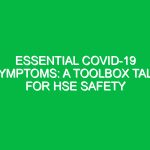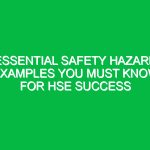Introduction
Safety communication is the cornerstone of effective Health, Safety, and Environment (HSE) management. It encompasses the methods and processes through which Safety information is conveyed among employees, management, and other stakeholders. In industries where Hazards are prevalent, such as construction, manufacturing, and chemical processing, the importance of clear and effective Safety communication cannot be overstated. Miscommunication can lead to accidents, injuries, and even fatalities, making it crucial for organizations to adopt robust safety communication strategies.
This article delves into essential safety communication strategies that promote HSE success. By exploring key components, best practices, and regulatory considerations, we aim to provide a Comprehensive Guide for organizations seeking to enhance their safety communication efforts. Along the way, we will include real-life examples and actionable insights to illustrate the significance of effective communication in the realm of health, safety, and environmental management.
The Key Aspects of Safety Communication in HSE
Safety communication involves several critical components that work collectively to ensure a productive and safe work environment. These components include clarity, consistency, feedback, and engagement, each playing a vital role in effective communication.
1. Clarity
Clarity in safety communication means conveying information in a straightforward and understandable manner. This involves using plain language and avoiding jargon when possible. For instance, when discussing safety Procedures, instead of saying, “Implement the risk mitigation protocols outlined in the safety management system,” one might say, “Follow the steps we have outlined to reduce risks.” This makes the information accessible to all employees, regardless of their background or experience level.
2. Consistency
Consistency in messaging is equally important. When safety messages are delivered consistently across various channels—such as safety meetings, training sessions, and internal communications—employees are more likely to remember and follow these directives. For example, if a company implements a new safety policy, it should be communicated through email, posted on bulletin boards, and discussed in team meetings to ensure that everyone is on the same page.
3. Feedback
Feedback mechanisms are crucial for effective safety communication. Organizations should encourage employees to share their thoughts on safety communications, whether through surveys, suggestion boxes, or open forums. For instance, a manufacturing company that regularly seeks input on its safety protocols can identify areas that are unclear and improve its communication strategies accordingly.
4. Engagement
Engaging employees in safety discussions fosters a culture of safety and accountability. When employees feel involved, they are more likely to adhere to safety practices. Companies can achieve this by conducting regular safety drills, hosting safety workshops, and encouraging peer-to-peer communication about safety concerns. For example, a construction firm might hold weekly Toolbox Talks where workers discuss safety issues relevant to their tasks, reinforcing their commitment to safety.
Best Practices for Safety Communication
Implementing effective safety communication strategies requires adherence to Best Practices that have been shown to enhance understanding and compliance. Below are several Best Practices that organizations can adopt.
1. Use Visual Aids
Visual aids, such as posters, infographics, and videos, can significantly enhance safety communication. Studies have shown that individuals retain information better when it is presented visually. For example, a chemical plant might use clear signage to indicate hazardous materials and emergency exits, ensuring that employees can quickly absorb critical safety information.
2. Tailor Communication to the Audience
Understanding the audience is key to effective safety communication. Different teams may have varying levels of experience and familiarity with safety protocols. Tailoring messages accordingly ensures that everyone understands the information being presented. For instance, new employees might require more detailed Training on safety procedures compared to seasoned workers, who may need brief refreshers.
3. Foster a Culture of Open Communication
Creating an environment where employees feel comfortable discussing safety concerns is essential. This can be achieved through leadership support and the establishment of non-punitive reporting systems. For example, a healthcare organization might implement a system where nurses can report near-miss incidents without fear of retribution, allowing for improved safety practices based on real experiences.
4. Continuous Training and Development
Regular training sessions are vital for keeping safety information fresh in employees’ minds. Organizations should schedule ongoing training that incorporates new safety information, changes in Regulations, and lessons learned from past incidents. A construction company, for instance, could hold monthly safety training sessions that include hands-on demonstrations and updates on industry best practices.
Potential Hazards and Risks Associated with Poor Safety Communication
Ineffective safety communication can lead to a variety of hazards and risks that compromise employee safety and organizational integrity. Here are some of the most significant risks associated with poor communication:
1. Increased Accident Rates
When safety information is unclear or inconsistent, employees may not fully understand the risks associated with their tasks. This lack of understanding can result in accidents, injuries, and even fatalities. For example, in a manufacturing facility, unclear instructions on operating machinery may lead to improper use and accidents.
2. Regulatory Non-Compliance
Organizations that fail to communicate safety protocols effectively may find themselves non-compliant with local and national regulations. This can result in legal penalties, fines, and damage to the company’s reputation. For instance, a chemical company that does not adequately communicate hazardous material handling procedures could face significant legal repercussions.
3. Low Employee Morale
Poor safety communication can contribute to low employee morale, as workers may feel undervalued or unsafe. When employees perceive that their safety is not a priority, their engagement and productivity can decline. A construction site with frequent miscommunication regarding safety protocols may see a rise in absenteeism and a decline in job satisfaction.
Regulations and Standards Governing Safety Communication
Adhering to safety regulations is a fundamental aspect of effective safety communication. Various regulations and standards outline the requirements for safety communication in the workplace. Here are some key regulations to consider:
1. Occupational Safety and Health Administration (OSHA) Standards
In the United States, osha sets forth regulations that mandate effective safety communication in the workplace. For example, the Hazard Communication Standard requires employers to provide information about hazardous chemicals in the workplace. This includes labeling, safety data sheets, and employee training.
2. ISO 45001
ISO 45001 is an international standard that outlines requirements for an Occupational Health and safety management system. It emphasizes the importance of communication in promoting a safe workplace and requires organizations to establish processes for communicating health and safety information effectively.
3. Environmental Protection Agency (EPA) Regulations
The EPA also imposes regulations regarding safety communication, particularly concerning hazardous waste management and environmental protection. Organizations must communicate effectively about environmental risks and Safety Measures to ensure compliance with these regulations.
Conclusion
In conclusion, effective safety communication is essential for achieving success in health, safety, and environmental management. By understanding the key aspects of safety communication, adhering to best practices, and recognizing the potential hazards associated with poor communication, organizations can foster a culture of safety that protects employees and promotes compliance with regulations. As the saying goes, “An ounce of Prevention is worth a pound of cure.” Investing in safety communication not only enhances Workplace Safety but also contributes to overall organizational success.
To foster a culture of safety, organizations must prioritize open communication, ongoing training, and employee engagement. By doing so, they can mitigate risks, improve morale, and ensure compliance with safety regulations. As we move forward in an increasingly complex work environment, the importance of effective safety communication will only continue to grow.


